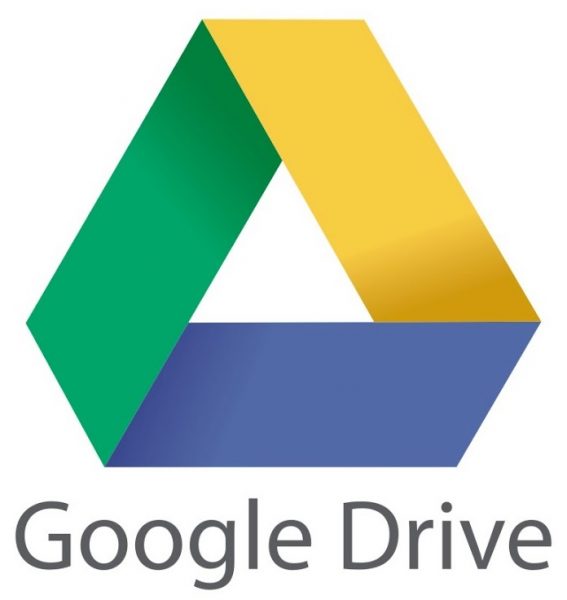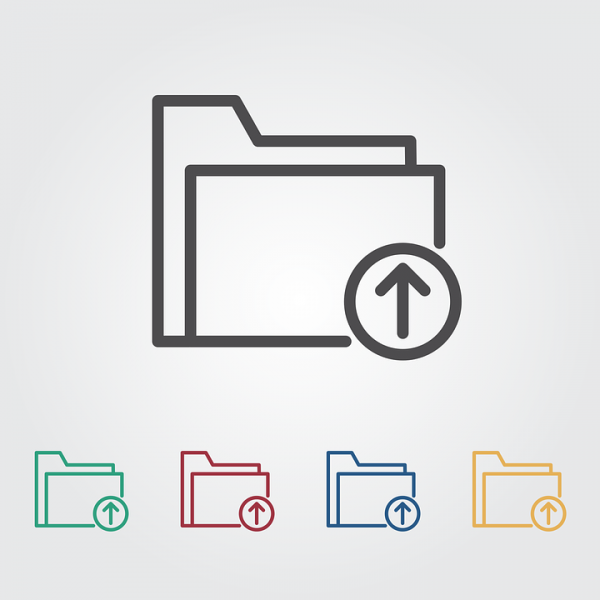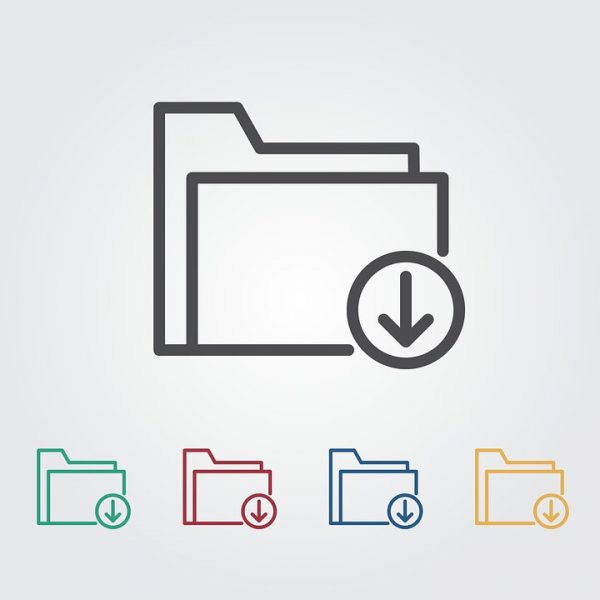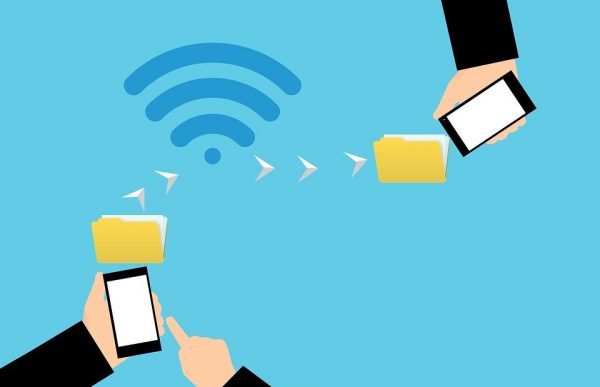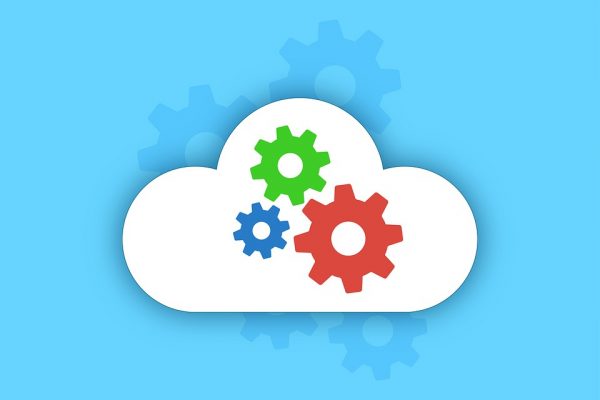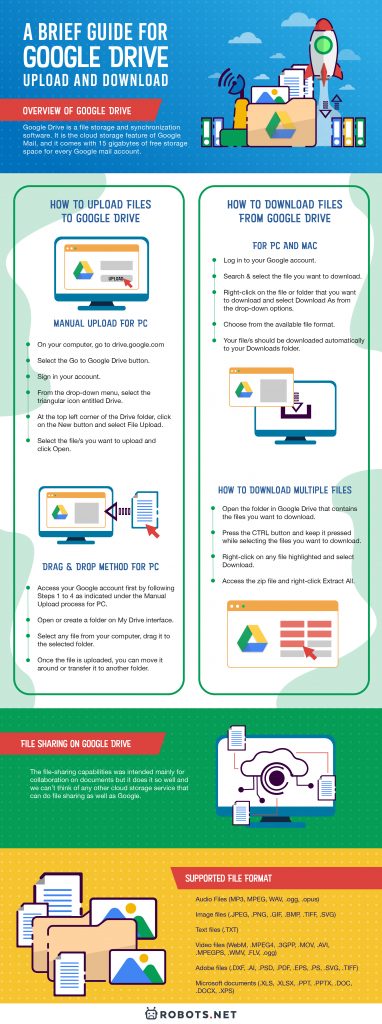Overview of Google Drive
Google Drive is a file storage and synchronization software. It is the cloud storage feature of Google Mail, and it comes with 15 gigabytes of free storage space for every Google mail account. Google launched the feature in April 2012 and introduced the iOS app two months later. Google later incorporated new changes to the design and user interface. The improved version of the software lets users compress and download large files and also upload and edit large files online. File owners are given several access options (editing, commenting, and viewing) to choose from and the files sync automatically to incorporate all changes in real-time. Google Drive lets you create, store, and edit word documents, spreadsheets, presentations, forms, and drawings. Video, audio, graphics, and online content files are also acceptable for storage in the Drive. There’s also a template gallery with a multitude of designs and templates for each file category. Google Drive has paid premium offerings with varying storage capacities for organizations and individuals. These include Google Drive for Work, Google Drive Enterprise and Google Drive Education.
Disruptive Technology
Google Drive aims to promote a fully digital, paperless working environment. By introducing radical changes in the way people work and store data, Google Drive may also be considered as a positive, disruptive force that moves society towards higher efficiency and productivity. Google Drive is an exemplar of the far-reaching applications of cloud technology and serves as a contributing force towards Industry 4.0. There has been some controversy regarding the privacy settings of Google Drive, as some believe that the information is part of a larger scheme involving Google searching user information for personal information to feed into the marketing intelligence of other companies. However, there is no evidence to support this assertion and Google Drive has so far maintained a solid reputation among users. Google Drive runs on Windows and Macs with a configuration of Windows 7 or later and Macs running OS X Lion or later. It’s also available for Android phones and tablets with a configuration of 4.1 or later, and Apple phones and tablets with a system configuration of iOS 8 or later.
How to Upload Files to Google Drive
Cloud technology makes Google Drive uploads easy to do and easy to manage. Files can be uploaded to Google Drive through any device, and there are two ways to do it. One by is manual upload and the other by the Drag and Drop method. Before we begin, it’s important to note that Google Drive only lets you upload files that would fit 15 gigabytes of storage. Anything more than that and you’d have to pay for additional storage. Also, note the difference between file upload and folder upload. File upload lets you select a specific file or group of files to be uploaded. Meanwhile, the folder upload lets you select a specific folder from your desktop for which all contents will be included in the Google Drive upload.
Manual Upload for PC
Uploading your file manually is the traditional way of saving a file on your cloud storage. Manual uploads ensure that the file is not lost as the downloading process is visible to the user. Google Drive permits each user to upload a maximum of 750 gigabytes of data per day. If you are uploading a single file, it should be less than 5 terabytes to be uploaded. File uploads vary in duration and depend on your file size and internet connection speed. To manually upload your files, follow the following steps:
- On your computer, go to drive.google.com
- Select the Go to Google Drive button.
- Key in your email address and password to access your Google account.
- Click on the Options icon on the main page. The icon has nine symmetrical dots arranged by threes located on the upper right-hand corner of the main page. From the drop-down menu, select the triangular icon entitled Drive.
- At the top left corner of the Drive folder, click on the New button and select File Upload.
- The file upload window should appear. Select the file/s you want to upload and click Open.
- You should see a notification for Upload complete which indicates the file transfer is successful.
Drag and Drop Method for PC
Drag and Drop is a technique to upload files quickly and in bulk. Google made this possible following system improvements in Google Drive. This saves you a few seconds as you don’t have to access the file upload window and it automatically copies to your Google Drive.
- Access your Google account first by following Steps 1 to 4 as indicated under the Manual Upload process for PC.
- Open or create a folder on the My Drive interface.
- Select any file from your computer that you want to upload to your Google Drive and drag it to the selected folder.
- To upload multiple files at once, hold down the CTRL key and select all files and drag to the folder.
- You should see a notification for Upload complete which indicates the file transfer is successful.
- Once the file is uploaded, you can move it around or transfer it to another folder by simply selecting the file and dragging it to the folder.
For Mac
- Access your Google account first by following Steps 1 to 4 as indicated under the Manual Upload process for PC.
- Once you have signed in to your account, click on the Create button found on the left-hand panel.
- Select Folder and create a name for your folder. This will be the folder where your files will be uploaded.
- Click on the Upload button right next to the create button and select the File option.
- The file upload window should appear. Select the file/s you want to upload and click Open.
- You should see a notification for Upload complete which indicates the file transfer is successful.
- The Drag and Drop method also works on Mac computers. Open the folder on Google Drive that you want to transfer the file to.
- Click on the file and drag it towards the Google Drive folder.
For Android
- Open the triangular Google Drive icon from your list of applications. You need to be logged in to your Google Account to be able to access Google Drive. If you haven’t logged in, click on the sign-in notification. On the Google log-in page, key in your email address and password.
- Tap the blue, circular button with a white cross in the middle. This can be found at the lower-right corner of your screen. A pop-up menu should appear.
- Select the icon for Upload. This is depicted as a grey arrow pointing upwards and a line underneath.
- Select a file location from the menu. This could be any folder from your device with documents, photos or videos.
- To select any file for upload, tap and hold for a few seconds. Multiple files can be selected.
- Select the Upload button and your files will start to upload into Google Drive. You should see a notification for Upload complete. This indicates the file transfer is successful.
- The Drag and Drop method also works on Android phones and tablets. Open the folder on Google Drive that you want to transfer the file to. Click on the file and drag it towards the Google Drive folder.
For iOS
- Follow steps 1 to 3 as indicated for downloading files for Android devices.
- A menu page should appear asking you to choose between Browse and Photos and Videos. The Browse option is for uploading documents while the photos and videos option are for media files of varying format.
- Select the file/s you want to upload by tapping on them. Multiple files can be selected. Note that iOS immediately downloads the selected file.
- You should see a notification for Upload complete which indicates the file transfer is successful.
- The Drag and Drop method also works for iOS phones and tablets. Open the folder on Google Drive where you want to transfer the file to.
- Click on the file and drag it towards the Google Drive folder.
How to Download Files from Google Drive
Google Drive uploads and other shared files are downloadable if you want to keep a copy on your computer. Having copies of files on your computer works best for when you don’t have an internet connection or if you intend to edit your files offline. Google Drive occasionally blocks sharing for files especially when the file generates a large amount of traffic since this can affect the speed of Google servers. When this happens, Google will send you a notification indicating that you cannot download the file because it has been viewed and downloaded too many times. This happens more frequently with media files. The Google Help page doesn’t specify the exact quota for downloads but some users estimate that the limit must be around 20 GB per day, with a higher limit for external downloads. To be safe, it might be best to reserve Google Drive for your work files and the most important files. Any file or folder you download from Google Drive will still be kept where you found it. Google Drive is essentially only providing you with a copy for offline use. If you intend to download multiple files, you might want to create a new folder on your computer first to put all your downloaded files in one place. There is no Drag and Drop feature for downloading files. This means dragging files from Google Drive to your desktop will not have any effect.
For PC and Mac
The steps in downloading files are essentially the same for PC and Mac since the access point is the Google Drive main page.
- Log in to your Google account and access the Google Drive main page.
- From the main page, the My Drive tab should be automatically highlighted. This should display your Recent files and miscellaneous folders.
- Select the file you want to download. You can also search for it using the Search Drive toolbar directly above the My Drive interface.
- Right-click on the file or folder that you want to download and select Download As from the drop-down options. This should open up a drop-down list of file formats.
- Choose from the available file format (MS Word, OpenDocument, RichText, PDF, Plain Text, etc.). Select one that is compatible with your file tools (i.e. Microsoft tools, Adobe PDF, etc.).
- Your file/s should be downloaded automatically to your Downloads folder. The file name and download progress should also be reflected at the bottom of your web browser taskbar.
- Check the Downloads folder of your web browser and click on the file.
For iOS
- Open the triangular Google Drive icon from your list of applications.
- Access the main page and search for the file you want to download under Search Drive.
- On the file, you want to download, tap on the More toolbar with three dots to the right side of the file and click Send a copy.
- Tap the Save file button and the file will be forwarded to the Downloads folder of your iPhone or iPad.
For Android
- Open the triangular Google Drive icon from your list of applications.
- Access the main page and search for the file you want to download under Search Drive.3
- On the file you want to download, tap on the More toolbar. This is the three dots located on the upper right side of the file. Click Download.
- You will receive a notification about the completed download. The file should be forwarded to the Downloads folder of your phone or tablet.
How to download multiple files
- Open the folder in Google Drive that contains the files you want to download.
- Press the CTRL button and keep it pressed while selecting the files you want to download.
- Once you’re done selecting files for download, right-click on any file highlighted and select Download. All the files you selected will be downloaded into one folder as a zip file.
- Access the sip file and right-click Extract All. Select the folder where you want the extracted files to go.
File Sharing on Google Drive
Next to its file storage capabilities, the file-sharing capabilities of Google Drive are the next best thing about it. The file-sharing capabilities was intended mainly for collaboration on documents but it does it so well and we can’t think of any other cloud storage service that can do file sharing as well as Google. Read on to find out this innovative, collaborative feature of our favorite cloud storage and editing software:
Which types of files can be uploaded or downloaded on Google Drive?
You can create, edit, and upload almost any type of file in Google Drive. The type of files commonly uploaded are documents, spreadsheets, presentations, forms, and drawings. Other types of files including video, audio, graphics, online content, adobe files for storage in the drive. Google Drive is also fully compatible with Microsoft documents, so you won’t need to convert your Excel, Powerpoint, Word, or XML files. Google Drive has its own document tools so you can create any document while online. There’s also a template gallery with a multitude of designs for each file category.
Supported File Format
Google Drive supports the following files and file format:
Audio Files (MP3, MPEG, WAV, .ogg, .opus) Image files (.JPEG, .PNG, .GIF, .BMP, .TIFF, .SVG) Text files (.TXT) Video files (WebM, .MPEG4, .3GPP, .MOV, .AVI, .MPEGPS, .WMV, .FLV, .ogg) Adobe files (.DXF, .AI, .PSD, .PDF, .EPS, .PS, .SVG, .TIFF, .TTF) Microsoft documents (.XLS, .XLSX, .PPT, .PPTX, .DOC,.DOCX, .XPS)
How to share files through Google Drive
Google Drive files are shareable to others for collaboration purposes. The only requirements are that the recipient of the file must also have a Google account to be able to access the file. The first way to share files is to have Google Drive send it directly to your recipients through Google mail. The second way is for you to copy the link and send it to others yourself through Link Sharing.
How to share files through Google Mail
- Locate the file you would like to share and open it. Click the Share button on the upper right-hand corner of the main page to access Sharing Settings. A Share with Others notification should appear.
- Enter the name or email addresses of the people you want to share the file with. Note that names are only searchable if the individual is already part of your contact list. Otherwise, Google will ask you to input their email address.
- Click on the drop-down toolbar beside the search bar. Don’t forget to choose the access type for the individuals you are sharing the file with (Edit, Comment, and View).
- Click Send when you are ready to send the file. You can also add a host message for the people who will receive your file or leave it blank.
- Recipients of the file should be able to receive a Google mail notification to allow them to open the file. Depending on the access type, they will be able to make real-time changes to the file or leave comments. Icons will pop up near the message bar of the main page to let you know when another user is viewing, editing, or commenting on the document.
How to share files through Link Sharing
- Locate the file you would like to share and open it.
- Click the Share button on the upper right-hand corner of the main page. A Share with Others notification should appear.
- For an unopened file in any folder, right-click the file and select “Get Shareable Link.” Copy the link.
- For files already opened, look for the Copy Link option beside the access type options. There’s also a green Get Shareable Link toolbar on top. Click either one of these to copy the link. Note also that you need to set the access type (Edit, Comment, and View).
- Paste the link to a separate application to send it. This can be done through Google email, Facebook Messenger, WhatsApp or any other social media apps.
How to Access Shared Links
- If you are the recipient of a link, a notification should appear on your Google Mail inbox. It will indicate that a certain person is requesting you to edit, comment or view a document. Open the email notification by clicking on Open in Sheets or Open in Documents.
- Clicking on the link should lead you directly to the page and you’ll also be able to download the file should you want to.
- To look for a shared file directly on Google Drive, click Shared drives or Shared with me button on the left-hand panel of the main page. Locate the document from either of these panels and open it normally.
- If you receive an email notification but cannot access the file, you’ll need to send a request to the sender for access. On the pop-up notification indicating You Need Access, click on Request access.
- The owner of the file will then receive an email notification to grant the request. The most likely reason for blocked access is that the owner or sender was not able to configure the settings properly.
- An email notification will be sent to you once the request has been granted. Open the notification and access the file.
- If you are the sender of the file that cannot be opened, go to Sharing Settings on the main page of Google Drive and set the file access (Edit, Comment, and View).
Locating Uploaded and Downloaded Files
Having a collection of files doesn’t always make it easy to search for the file that you need. Looking for files can be a very time consuming and unnecessary task. We’ve come up with a few tips to help you locate files that you have uploaded to or from Google Drive in a jiffy.
Uploaded files
A Google Drive upload can also be downloaded later on. To access uploaded files, click on the Drive button on the left panel. Once you’ve accessed the main page, most of the toolbars on the left-hand side can be used to search for your files. There’s a Quick access panel for recent files uploaded and edited. The folders on the main page are arranged by the time of upload. You’ll see different categories for files including Recent, Shared with Me, Starred, and Offline. To search for your file, you can either scroll through the list of folders or type in the name of the file into the Search Drive toolbar. This toolbar is directly above the My Drive interface.
Downloaded files
To access files you’ve just downloaded from Google Drive, you’ll need to check on the Menu tab on the upper right-hand corner of your web browser. There you’ll see three white dots that are vertically arranged. Click on this icon and select Downloads. This should open the downloads page with all the downloaded files arranged in chronological order. Scroll through and click on the file you want to access. Windows downloads are directed to Downloads or Documents folders by default. If the file doesn’t appear in the Downloads folder, check other folders on your computer. Windows might have saved the file in a different folder after it was downloaded. Type in the name of the file under your document search toolbar to confirm. If you really cannot find the file, consider downloading it again from Google Drive.
Google Drive Settings
How do I access my Google Drive Settings?
Google Drive lets you customize several interface and processing aspects of its software. You can control the conversion of uploaded files, offline use. In addition, there are control options to allow the user to change the density of search results and customize notifications for browser and email. To access Google Drive Settings, follow the following steps:
- Log-in to Google Drive.
- On the main page, click on the Settings icon on the upper right-hand side of the screen. This icon looks like a circular machine wheel.
- From the drop-down menu, select Settings again.
- With the Settings tab, you can buy additional storage space for your Google Drive and convert uploaded files to Google Docs. Meanwhile, an offline Google Drive extension lets you create, open and edit files without an internet connection.
- You can also control the updates that appear through your email or web browser about changes made to your Google Drive. You can also connect to other Google apps through Google Drive (i.e. Google Apps Script, Google Earth, Google My Maps, etc.). You can control settings for each app through the Manage Apps option.
How do I make Google Drive the Default Windows cloud?
By default, Windows saves all files to My Documents. You can make Google Drive upload and download seamless and automatic by instructing Windows to save your files directly to Google Drive. Follow the following steps to set Google Drive as default:
- Open File Explorer. A shortcut would be to press Windows key + E.
- Right-click on the Documents folder from the left-hand panel.
- Click on the Location tab and click Move. A separate window will open.
- Select Google Drive and then click Select Folder.
- Confirm the setting change by clicking OK.
- The system will ask you if you want to transfer new files in the Document folder to Google Drive. We recommend accepting the transfer since Google Drive is now your default storage. This will also keep your files safe online. However, it will not be necessary to transfer files this way if you already have Backup and Sync running on the background.
Final Thoughts on Google Drive Features
We hope that the tips we provided will help you become more efficient and skilled at Google Drive uploads and downloads. We also hope it will help you see all the wonderful features of the software that you can maximize. Although, you need to remember that keeping your files safe and organized is a two-way thing. You need to pay attention to your files to keep them that way. And with these tips and tricks, we do not doubt that you’ll be able to maximize everything that the software has to offer.
